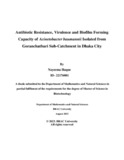| dc.description.abstract | The presence of ESBL producing Acinetobacter baumannii is a major concern for various hospital and community healthcare settings, often being linked to an increased incidence of nosocomial infections. The biofilm formation ability of A. baumannii enables it to be a persistent pathogen in these environments Furthermore, there is some evidence that environmental transport of Acinetobacter spp. plays a role in the spread of clinically relevant Acinetobacter strains in the environment. The objective of this study is to isolate ESBL positive A. baumannii from environmental samples, molecular confirmation of the presence of major ESBL and virulence genes, determination of antibiotic susceptibility profile and biofilm formation assay of the ESBL producing isolates. In this study we investigated the molecular characterization of ESBL forming A. baumannii in aquatic environment. Between April and December 2022, with 3 rounds of sample collected on 3 different seasons a total of 21 samples were collected from environmental sources and finally the study was conducted using 56 ESBL producing A. baumannii isolates. ESBL A. baumannii was isolated from those samples and the isolates were subjected to antibiotic susceptibility, PCR analysis for presence of resistance and virulence genes, and lastly biofilm formation assay. A total of 56 ESBL producing A. baumannii were isolated among them, 71.4% were positive for blaTEM gene, 5.4% were positive for blaSHV gene. Among the virulence factors, 76.8% isolates harbored the pgaB gene, 69.6% bfmS, 64.3% csuE, 62.5% ompA, 28.6% kpsMII, 26.8% ptk and epsA genes, 10.7% fimH and 5.4% bap gene. In regard to antibiotic susceptibility testing, 8.9% of the isolates were resistant to cefotaxime, 5.4% to cotrimoxazole and piperacillin/tazobactam, 1.8% tetracycline. On the other hand, 91.1% of the isolates were intermediately resistant to cefotaxime and 87.5% to ceftriaxone. Out of all the 56 isolates one isolate was found to be multi-drug resistant (MDR). In case of biofilm formation, at a temperature of 25ºC, 1.78% isolates were found to be strong biofilm formers, 7.14% isolates were moderate biofilm formers, 66.07% were weak biofilm formers. At a temperature of 37ºC, 1.78% isolates were moderate biofilm formers, 76.78% isolates weak biofilm formers. This study suggests that the ESBL producing A. baumannii is spreading from the healthcare settings to the environments at a rapid speed in Bangladesh, acting as a potential reservoir for AMR bacteria. The information may have a profound effect in contributing to the improvements in public health care policies, which are a necessity to combat the spread of antibiotic resistant strain in the environment. | en_US |

